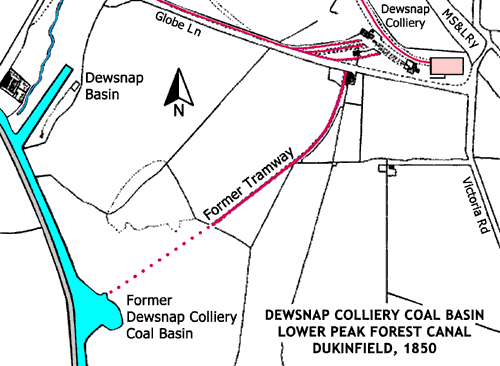
Dewsnap Colliery at Dukinfield was first operated by the Dunkirk Coal Company and it was connected by tramway to Dewsnap Colliery Coal Basin on the offside of the Peak Forest Canal. Later, this basin and tramway were abandoned and replaced by a longer tramway running along Globe Lane that connected with Chapel Basin. There was also a connection to the Manchester, Sheffield and Lincolnshire Railway. The Tithe Map of 1850 confirms that Dewsnap Coal Basin and associated tramway to have been abandoned by this time.
Dewsnap Colliery Coal Basin was situated about midway between Dewsnap Basin and the Newton Wood Private Branch. The Ordnance Survey map of 1875 shows no trace of the former existence of either this basin or its tramway.
For details of Dunkirk Coal Company click here » Dunkirk Coal Co

The geology of the Tameside area is such that the Middle Coal Measures of the Carboniferous Period run north-south under the area. It is situated on the site of extensive swamps and lakes and this is the reason why coal formed here. The coal deposits hereabouts lie below the Dukinfield Marine Band, which is the local name for the widespread Aegiranum Marine Band that includes the Lancashire Coalfield. From Dukinfield these particular coal deposits extend towards Ashton Moss to the north-west and Stockport to the south-west. Consequently, the Dukinfield Marine Band outcrops at Dukinfield and continues both up the hillside and downwards towards the Cheshire Plain. The coal strata, known as seams or mines, are underlaid with ‘seatearth’ which is a sedimentary rock representing the soil that supported the vegetation from which the coal was formed. It contains traces of roots and rootlets. Seatearth can also consist of fireclay which is a sedimentary mudstone.
Of the coal mines in Dukinfield it was found that Astley Deep Pit, situated to the west of Dewsnap Colliery, had the best coal and this was used for steam generation in nearby mills and for heating purposes. In contrast to this the coal from Dewsnap Colliery was of inferior quality and consequently in less demand. This resulted in its early closure and replacement by Dewsnap New Pit near Astley Deep Pit where the coal was of better quality. The shaft of Dewsnap New Pit was sunk in 1845/46.